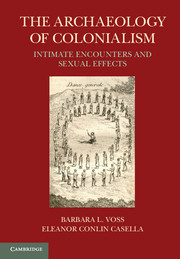Book contents
- Frontmatter
- Contents
- List of Illustrations
- List of Tables
- List of Contributors
- One Intimate Encounters
- Two Sexual Effects
- Section I Pleasures and Prohibitions
- Three Little Bastard Felons
- Four The Currency of Intimacy
- Five “A Concubine is Still a Slave”
- Six The Politics of Reproduction, Rituals, and Sex in Punic Eivissa
- Section II Engaged Bodies
- Section III Commemorations
- Section IV Showing and Telling
- Conclusion
- Index
- References
Six - The Politics of Reproduction, Rituals, and Sex in Punic Eivissa
from Section I - Pleasures and Prohibitions
Published online by Cambridge University Press: 05 June 2012
- Frontmatter
- Contents
- List of Illustrations
- List of Tables
- List of Contributors
- One Intimate Encounters
- Two Sexual Effects
- Section I Pleasures and Prohibitions
- Three Little Bastard Felons
- Four The Currency of Intimacy
- Five “A Concubine is Still a Slave”
- Six The Politics of Reproduction, Rituals, and Sex in Punic Eivissa
- Section II Engaged Bodies
- Section III Commemorations
- Section IV Showing and Telling
- Conclusion
- Index
- References
Summary
Introduction
Clay human figurines may be thought of as material culture with diverse dimensions because they are considered representations of a given reality. They betray the ways that people perceive both themselves and others. However, the methods and approaches available to us for the interpretation of such figurines vary widely. Although the most common approach is to study their functionality in relation to their iconography, this strategy establishes single explanations and rules out many other possible interpretations. In this chapter, it is my intention to study clay figurines from a corporeal and embodied point of view to shed light on questions of reproduction, sex, and gender in Punic society of the sixth to the second centuries bce. Following the main goals of this volume, figurines materialize the important role of intimate encounters in cultural contact situations.
To this end, I concentrate on a group of figurines recovered from the sanctuary of Illa Plana on the island Eivissa (also known as Ibiza), of the Baleric Islands of modern Spain (Figure 6.1; Almagro Gorbea 1980; Aubet 1969; Ferron and Aubet 1974; Hachuel and Marí 1988; San Nicolás 1987; Tarradell and Font 1975). First, I connect the figurines with their political and social context by concentrating on the politics of reproduction in Punic societies, especially on the island of Eivissa. Second, I consider the role of sex as a ritual performance. I intend to argue that the figurines ritualize sexual activities. Finally, I analyze the attribution of gender to the figurines within established scholarly discourse to expose traditional assumptions regarding gender as based primarily on a bipolar model of heterosexual representation. I suggest other interpretive possibilities beyond this duality, taking into account queer theory approaches, in accordance with the themes of this volume.
- Type
- Chapter
- Information
- The Archaeology of ColonialismIntimate Encounters and Sexual Effects, pp. 85 - 102Publisher: Cambridge University PressPrint publication year: 2011

